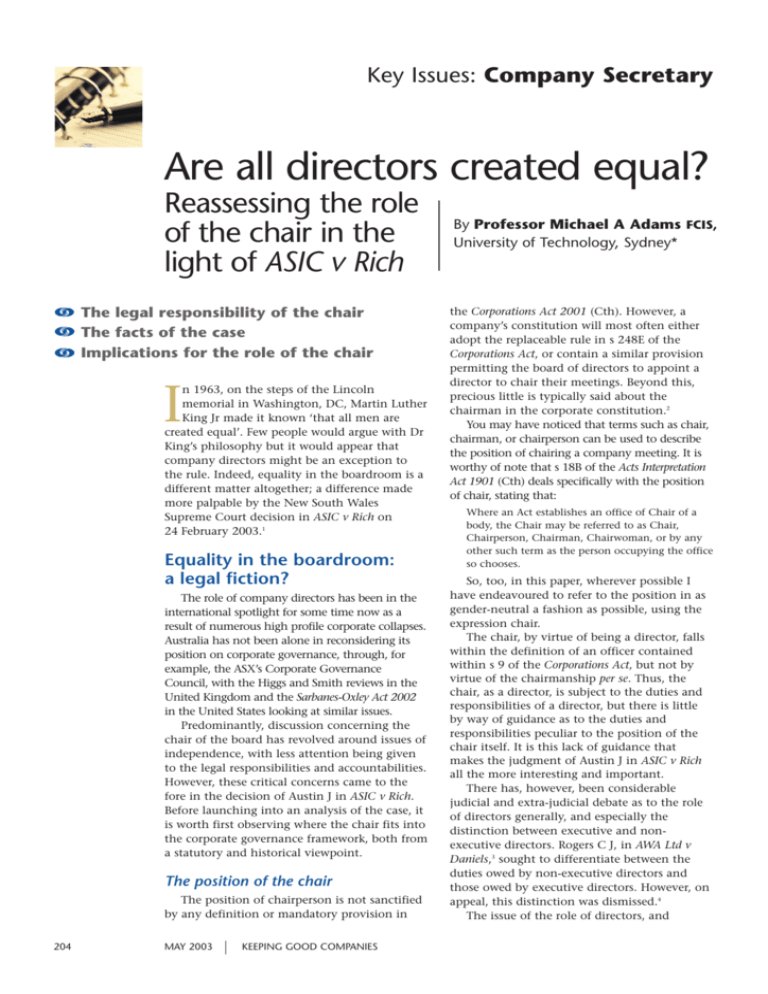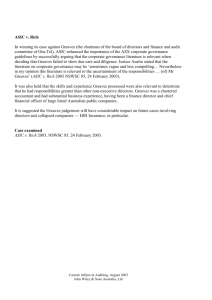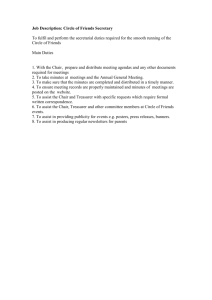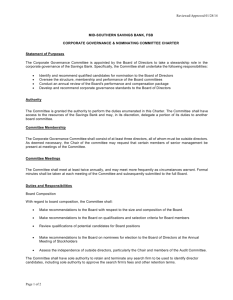Are all directors created equal? - OPUS at UTS
advertisement

Key Issues: Company Secretary Are all directors created equal? Reassessing the role of the chair in the light of ASIC v Rich The legal responsibility of the chair The facts of the case Implications for the role of the chair I n 1963, on the steps of the Lincoln memorial in Washington, DC, Martin Luther King Jr made it known ‘that all men are created equal’. Few people would argue with Dr King’s philosophy but it would appear that company directors might be an exception to the rule. Indeed, equality in the boardroom is a different matter altogether; a difference made more palpable by the New South Wales Supreme Court decision in ASIC v Rich on 24 February 2003.1 Equality in the boardroom: a legal fiction? The role of company directors has been in the international spotlight for some time now as a result of numerous high profile corporate collapses. Australia has not been alone in reconsidering its position on corporate governance, through, for example, the ASX’s Corporate Governance Council, with the Higgs and Smith reviews in the United Kingdom and the Sarbanes-Oxley Act 2002 in the United States looking at similar issues. Predominantly, discussion concerning the chair of the board has revolved around issues of independence, with less attention being given to the legal responsibilities and accountabilities. However, these critical concerns came to the fore in the decision of Austin J in ASIC v Rich. Before launching into an analysis of the case, it is worth first observing where the chair fits into the corporate governance framework, both from a statutory and historical viewpoint. The position of the chair The position of chairperson is not sanctified by any definition or mandatory provision in 204 MAY 2003 KEEPING GOOD COMPANIES By Professor Michael A Adams FCIS, University of Technology, Sydney* the Corporations Act 2001 (Cth). However, a company’s constitution will most often either adopt the replaceable rule in s 248E of the Corporations Act, or contain a similar provision permitting the board of directors to appoint a director to chair their meetings. Beyond this, precious little is typically said about the chairman in the corporate constitution.2 You may have noticed that terms such as chair, chairman, or chairperson can be used to describe the position of chairing a company meeting. It is worthy of note that s 18B of the Acts Interpretation Act 1901 (Cth) deals specifically with the position of chair, stating that: Where an Act establishes an office of Chair of a body, the Chair may be referred to as Chair, Chairperson, Chairman, Chairwoman, or by any other such term as the person occupying the office so chooses. So, too, in this paper, wherever possible I have endeavoured to refer to the position in as gender-neutral a fashion as possible, using the expression chair. The chair, by virtue of being a director, falls within the definition of an officer contained within s 9 of the Corporations Act, but not by virtue of the chairmanship per se. Thus, the chair, as a director, is subject to the duties and responsibilities of a director, but there is little by way of guidance as to the duties and responsibilities peculiar to the position of the chair itself. It is this lack of guidance that makes the judgment of Austin J in ASIC v Rich all the more interesting and important. There has, however, been considerable judicial and extra-judicial debate as to the role of directors generally, and especially the distinction between executive and nonexecutive directors. Rogers C J, in AWA Ltd v Daniels,3 sought to differentiate between the duties owed by non-executive directors and those owed by executive directors. However, on appeal, this distinction was dismissed.4 The issue of the role of directors, and particularly that of non-executive directors, remains very much a live one. The recent major collapses around the globe have ensured that the role of directors remains squarely in the spotlight. Subsequently, multiple reviews and reports have been ordered, legislation has been passed, and much has been said about the virtues of and necessity for independent directors, the splitting of the roles of chair and chief executive, and the need for greater accountability generally. Notwithstanding all this debate, the role and responsibilities of the chair somehow retain a certain mercurial quality, evading the attention of judges and the prescripts of legislation. In ASIC v Rich, Austin J reviewed the last one hundred years of case law vis-à-vis the role of the chair and found that: What emerges from these cases is that the chairman has specific authority of a procedural kind when chairing meetings of directors or members. These cases do not attribute to the chairman any wider non-procedural functions or responsibilities, but they do not deny the possibility that wider responsibilities might exist.5 It is arguable that the judgment of Austin J is the most extensive review to date of the legal responsibilities of the chair and it highlights the need for greater attention to the subject. However, I believe that it does not go so far as to definitively enunciate what is expected of the chair of a modern Australian public company. ASIC v Rich: a summary The case related to civil penalty proceedings brought by the Australian Securities and Investments Commission (ASIC) against four former directors of failed telecommunications company One.Tel Ltd: Jodee Rich, Bradley Keeling, John Greaves and Mark Silbermann. Mr Greaves was a nonexecutive director. One.Tel also had three other non-executive directors, Lachlan Murdoch, James Packer, and Rodney Adler, none of whom were a party to the litigation. Mr Greaves was chair of the board and also of the Finance and Audit Committee. The ruling of Austin J relating to the duties and role of the chair was the consequence of Mr Greaves bringing an application to have ASIC’s case against him summarily dismissed on three grounds. The most relevant of these was his claim that ASIC had not disclosed a reasonable cause of action, because the duties to which ASIC alleged Mr Greaves was subject were not known to law. ASIC’s case was that each of the four defendants contravened s 180(1) of the Corporations Law (now Corporations Act 2001 (Cth)), which holds that: A director or other officer of a corporation must exercise their powers and discharge their duties with the degree of care and diligence that a reasonable person would exercise if they: (a) were a director or officer of a corporation in the corporation’s circumstances; and (b) occupied the office held by, and had the same responsibilities within the corporation as, the director or officer. (emphasis added) ASIC was seeking to prove that Mr Greaves had: special responsibilities beyond those of the other non-executive directors, by reason of his positions as chairman of the board and the Finance and Audit Committee, and also by reason of his high qualifications, experience and expertise relative to the other directors.6 Therefore, ASIC submitted that, as responsibilities for the purposes of s 180(1), those special responsibilities as a chair led to a higher standard of requisite care and diligence, which Mr Greaves failed to meet. ASIC outlined the alleged responsibilities in some depth, which were summarised by Austin J as being responsibilities with respect to: • the general performance of the board • the flow of financial information MAY 2003 • • • • • to the board (including information about cash reserves, actual segment performance and key transactions) the establishment and maintenance of systems for information flow to the board the employment of a finance director the public announcement of information the maintenance of cash reserves and group solvency and making recommendations to the board as to prudent management of the group.7 Thus, according to ASIC, the statutory duty of care and diligence (s 180(1)) led to the imposition upon Mr Greaves, given the circumstances, of a series of more specific duties, each of which he failed to discharge. It was argued by ASIC that the specific duties arose because a reasonable person, occupying Mr Greaves’ positions and having the same responsibilities (listed above) as he had within the corporation, would have acted, in the corporation’s circumstances, with a far greater degree of care and diligence. In accordance with the law, because the reasonable person contemplated by s 180(1) would have acted with such a degree of care and diligence, Mr Greaves had specific duties to do likewise.8 Mr Greaves’s argument to the contrary was that he had no such responsibilities, rather: he was a non-executive director, in essentially the same position as the three other non-executive directors who have not been sued by the Commission, notwithstanding that he was chairman of the board and of the Finance and Audit Committee.9 In finding for ASIC, Austin J felt comfortable with the fact that, while there was no precedent that directly attributed to the chair wider nonprocedural functions or responsibilities, the precedents do not deny the possibility that wider KEEPING GOOD COMPANIES 205 Company Secretary cont. responsibilities might exist.10 Austin J felt that ASIC had a ‘reasonably arguable case for the view that Mr Greaves had the responsibilities pleaded’,11 adding that the United Kingdom Higgs Review (released after ASIC’s submissions were completed) contained ‘emphatic statements which appear to reinforce the Commission’s evidence.’12 ASIC v Rich: a watershed, or watered down? Both the media and ASIC have made much of the findings of Austin J in ASIC v Rich, claiming it to be something of a watershed or landmark decision.13 It is possible to view the decision in two ways and, in turn, extract both a broad and a narrow theoretical principle. The broad principle, favoured by the media, is that the judgment is in fact a watershed decision that exposes all chairs to a greater level of accountability. The narrower, and arguably more realistic, principle is that the decision should largely be confined to its facts and is only applicable to chairs who are both chair of the board and of the Finance and Audit Committee, and who have extensive financial and commercial qualifications and experience. When considering the decision in context, there are two strong points that lend weight to the narrower principle. Firstly, the proceedings themselves; these were interlocutory proceedings, seeking a summary dismissal of ASIC’s civil penalty proceedings. Austin J has merely accepted that ASIC’s suggestions of expanded duties of chairmen is ‘reasonably arguable’. To date, there has been no finding against Mr Greaves that he definitely owed such duties, or that he was in breach of them. Secondly, Austin J makes it clear that ASIC’s case was not about establishing general principles of accountability. At paragraph 18, Austin J reminds us that: 206 MAY 2003 The case that the Commission seeks to make out is not a case about the duties of a company chairman at large, but about the duties of a company chairman who is also chairman of the audit committee, having regard to the particular circumstances of the company and his special personal qualifications. Lastly, it is worth remembering that the proceedings may well go on appeal. In light of these three considerations, it can be concluded that the decision in ASIC v Rich certainly opens the door for a widening of the duties of the chair generally, but stops well short of actually doing so. It can quite rightly be confined to its facts and one should be careful of reading too much into the judgment of Austin J. Rather, it is the outcome of the civil penalty proceedings against Messrs Rich, Silbermann and Greaves which may be far more telling and authoritative in terms of the role of the company chair. Corporate governance: ASIC v Rich and a move towards divergence In 1999, following several years of debate resulting in many countries developing their own corporate governance codes,14 two significant attempts were made at enumerating internationally acceptable principles of corporate governance. The Organisation for Economic Cooperation and Development (OECD) released its Principles of corporate governance and the Commonwealth Association for Corporate Governance (CACG) unveiled its Principles of best business practice for the Commonwealth. At the time, these bodies sought to capitalise on an apparent convergence of thinking on corporate governance and encouraged other countries to follow suit. However, since the collapse of Enron in the United States, the concept of international convergence appears a little fragile. Where the United States, the United Kingdom KEEPING GOOD COMPANIES and Australia could have been grouped together once in terms of corporate governance thinking, postEnron all three nations appear to be taking divergent approaches in reforming their corporate regulatory environments.15 A similar divergence in relation to Australia’s treatment of company directors may be apparent in the judgment of Austin J in ASIC v Rich. By agreeing with the concept of expanded duties of Mr Greaves as chair, Austin J has implicitly agreed with the idea of directors owing different standards of duty when they assume this additional position. This would appear to fly in the face of conventional common law and legislative thinking. Indeed, ever since the New South Wales Court of Appeal overturned the first instance findings of Rogers C J in AWA Ltd v Daniels16, which sought to differentiate between the duty owed by non-executive directors and that owed by executive directors, all directors have been viewed as being essentially equal in the eyes of the law.17 However, even this equality has only ever stretched so far. While it was agreed that directors should be subject to the same standard of duty, the responsibilities of directors in discharging their duties have been less certain. In amending s 232(4) of the old Corporations Law (the predecessor to s 180(1) Corporations Act), the Corporate Law Reform Bill 1992 (Cth) contained a shopping list of matters (sub–s 4AA) it proposed a court be required to consider for the purpose of determining whether or not a director had properly discharged the statutory duties. This list has been extensively critiqued recently in Keeping good companies,18 and was seen as being a de facto list of minimum responsibilities of company directors. The proposed subs 4AA was abandoned when the Corporate Law Reform Act 1992 (Cth) was passed. However, its relevance was Company Secretary cont. highlighted by Austin J in ASIC v Rich, who saw some resonances between it and ASIC’s submission as to the responsibilities owed by Mr Greaves.19 Interestingly, in accepting ASIC’s submission to widen the duties of the chair in question, Austin J concurred with some of the first instance observations of Rogers C J in AWA Ltd v Daniels, namely that ‘the chairman is responsible to a greater extent than any other director for the performance of the board as a whole and each member of it.’20 It is well known that the decision of Rogers C J in AWA Ltd v Daniels was overturned on appeal, but Austin J claimed that ‘nothing said by the Court of Appeal on appeal from Rogers J’s judgment…calls these observations into question.’21 In ruling that it may be pertinent for the responsibilities of the modern chair to be widened in certain circumstances, Austin J has proposed a divergence from the concept of equality between directors. Those that take on the role of chair may be faced with a greater standard of care, which would be affected by the corporation’s circumstances, the nature of the director’s office, and the director’s responsibilities. An individual chair will find these responsibilities will vary along a sliding scale, taking into account any arrangements flowing from the qualifications, experience and skills that the director brings to his or her office, and also any arrangements within the board or between the director and executive management affecting the work that the director would be expected to carry out.22 Qualifications of the chair: a new consideration in the light of ASIC v Rich? Everybody knows that directors of public companies must be appropriately qualified for the job. This is the assumption. Conventional layman’s thinking suggests that no major company would have a director on its board in the absence of appropriate qualifications and experience. Yet these requisite qualifications are not mandated by legislation or stock exchange listing rules. Sweeping requirements such as those found in the Corporate Governance Code adopted in Singapore, stating that ‘every company should be headed by an effective Board to lead and control the company’, are not uncommon, but do little to require board In ruling that it may be pertinent for the responsibilities of the modern chair to be widened in certain circumstances, Austin J has proposed a divergence from the concept of equality between directors. members to be qualified. The guidance notes to the Singaporean Code go further and propose that every director should receive appropriate training (in the duties of a director and how to discharge these duties) as soon as the director is appointed to the board.23 Legislation, such as Chapter 2D of Australia’s Corporations Act, often goes to great lengths to prescribe procedures for appointing, remunerating and terminating directors, and setting minimum and maximum age limits, but does not specifically require directors to be qualified, provided they can discharge their common MAY 2003 law, equitable and statutory duties. Despite the lack of a legal directive for qualified company directors and officers, professional bodies offer a range of educational courses for Company Secretaries, directors and the chair aimed at certifying them as qualified for the job, and aiding their understanding of the compliance issues they face. The number and variety of these courses lends weight to the commercial importance of directors being appropriately trained, qualified and up-to-date. This importance, with particular reference to the chair of the board, has been implicitly highlighted by the judgment of Austin J in ASIC v Rich and appears to have some unexpected outcomes. In ASIC v Rich, Mr Greaves’ high qualifications were one of the key factors that led to Austin J agreeing to the widening of his duties as chair of One.Tel. Thus, one might reasonably extend this finding to state, tentatively, that ASIC v Rich is authority for the idea that the better qualified chair may face higher obligations at law than a chair with fewer qualifications. The ramifications of this reality are not insignificant and beg several questions. Will this decision act as a disincentive, either to well-qualified directors considering taking on the position of chair or current wellqualified chairs, to continue in the role for fear of implications of these higher duties? Is it now safer for highly-qualified directors to stay as ‘ordinary’ directors, who are not subject to the higher responsibilities imposed upon the chair? These questions put the chair of the board in a difficult Catch-22 position: commercial practice dictates that all directors should be appropriately qualified, yet such qualifications open the chair to a greater level of responsibility. Hence, these questions are not easy to answer, particularly given the high likelihood of ASIC v Rich going on appeal. KEEPING GOOD COMPANIES 207 Company Secretary cont. The role of the chair: a final word ASIC v Rich is only one of a number of recent Australian cases flowing from the collapses of One.Tel and HIH Insurance. It is a decision that has the potential to influence the future direction taken by corporate law in regulating the conduct of members of the board. It should be remembered, however, that ASIC v Rich deals solely with the chair, and only the chair of the board who is also the chair of the Finance and Audit Committee and who has extensive qualifications and experience. Thus, for the moment, it can quite reasonably be confined to its facts, although it is prudent to reflect upon the role of the chair, as Austin J has paved the way for higher expectations in the future. In the current litigious atmosphere, fuelled by an eager regulator and an investor community baying for boardroom blood, all directors are well-advised to keep their noses clean and their houses in order. One need only look to the recent findings against Messrs Adler, Williams and Fodera in ASIC v Adler24 to realise that breaches of directors’ duties under the Corporations Act carry serious consequences and heavy penalties. It must be acknowledged that these proceedings have been appealed by Messrs Adler and Williams; however, at first instance, the three directors were found guilty of 182 breaches of their statutory duties as directors. In ASIC v Adler, the directors were found to have breached, amongst other things, s 180(1) of the Corporations Act. Mr Adler was a nonexecutive director of HIH Insurance, Mr Williams was the Chief Executive Officer, Mr Fodera was the finance director. Notwithstanding their very different roles within the company, they were all subject to the same duty of care and diligence. Interestingly, Mr Greaves was also charged with the same breach in 208 MAY 2003 ASIC v Rich, however, his liability arose as a result of his position as chair, rather than just as a director. It should be remembered, therefore, that s 180(1) encompasses all directors and officers of the company, and the statutory definitions of these positions are very broad. Despite the all-encompassing nature of s 180(1), the jury is still out in determining whether all directors are equal in the eyes of the law. Certainly, the judgment of Austin J in ASIC v Rich reflects public expectations and has fuelled the debate with intelligent and persuasive argument. The final outcomes of any appeal arising from this case, the actual civil penalty proceedings against Messrs Rich, Greaves and Silbermann, and the impact (if any) of the recent settlement between Bradley Keeling and ASIC25 will all go towards furthering discussion on the differential treatment of the chair and the board of directors. In addition, possibly the most important contribution to the debate is to be found in Justice Neville Owen’s report on the HIH Royal Commission. Without doubt, all directors should maintain a watching brief in order to monitor these key developments. In particular, in light of the decision in ASIC v Rich, chairs should be reviewing their directors’ and officers’ insurance policies for the relevant cover. Notes 1 2 3 4 ASIC v Rich [2003] NSWSC 85. Ibid at [53]. (1992) 7 ACSR 759; 10 ACLC 933. Daniels v Anderson (1995) 37 NSWLR 438. 5 ASIC v Rich [2003] NSWSC 85 at [56]. 6 Ibid at [4]. 7 Ibid at [15]. 8 Ibid at [27]–[29]. 9 Ibid at [5]. 10 Ibid at [56]. 11 Ibid at [70]. KEEPING GOOD COMPANIES 12 Ibid at [69]. 13 See, eg, Bill Pheasant, ‘Chairmen face greater legal burden, court rules’, The Australian Financial Review (Sydney), 25 February 2003, p. 1; Andrew Lumsden, ‘Better governance cannot eliminate risk’, The Australian Financial Review (Sydney), 26 February 2003, p. 63; Bill Pheasant, ‘BCA backs chairmen’s accountability’, The Australian Financial Review (Sydney), 26 February 2003, p. 6; ‘Leaders — Chairmen in the spotlight’, The Australian Financial Review (Sydney), 27 February 2003, p. 70; Australian Securities and Investments Commission, Landmark Decision on Chairman’s Duties, Press Release, No. 03–068 (24 February 2003) p. 1. 14 See, eg, Australia’s Bosch Report (1991); the United Kingdom’s Cadbury (1992), Greenbury (1995) and Hampel (1998) Reports; the United States’ Business Roundtable Statement on Corporate Governance (1997) and Blue Ribbon Committee Report (1999); and Canada’s Dey Report (1994). 15 Adams, MA, ‘Corporate Governance — What is the Best Model & Why?’ (Paper presented at the 2003 ASIC Summer School, Sydney, 11 March 2003) p. 23. 16 (1992) 7 ACSR 759; 10 ACLC 933. 17 See Daniels v Anderson (1995) 37 NSWLR 438. 18 See, Andrew Rogers QC, ‘AWA to HIH: Asleep at the post? The evolution of directors’ duties’ (2002) 54(10) Keeping good companies 597, p. 599. 19 [2003] NSWSC 85, [37]. 20 (1992) 7 ACSR 759 at 867. 21 [2003] NSWSC 85, [59]. 22 Ibid at [49]. 23 Kala Anandarajah, ‘Corporate Governance in Singapore’ in Low Chee Keong (ed), Corporate Governance — An Asia-Pacific Critique (2002) p. 309. 24 [2002] NSWSC 483. 25 See [2003] NSWSC 85. * Professor of Corporate Law and Assistant Director of UTS Centre for Corporate Governance, University of Technology, Sydney. The author wishes to thank the valuable research assistance of Jeremy Green.






